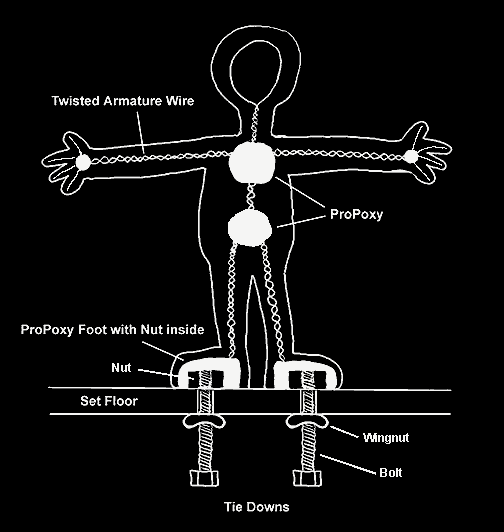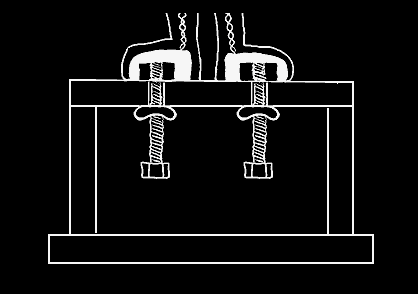THE SMA HANDBOOK ARCHIVE
Building a Wire Armature with Tie-Downs

Above is a diagram of a simple but effective wire armature for your Stop-Motion puppet.
THINGS YOU WILL NEED TO BUILD IT :
Propoxy 20 or similar material (available at Hardware stores)
2 narrow bolts, 2 nuts and 2 wingnuts
Sculpture or Armature wire (available at Art Supply stores) - Not too thick
Wire Cutters and Needle-Nose Pliers for cutting and twisting wire
Before you can begin building the armature, you need to have an idea what it will look like. Draw an actual size outline of your character on a piece of paper (like the one above) You can even draw where you want the armature to be roughly. Then get out the armature wire and begin to follow your design. You can start with the head and form a loop then proceed to twist the wire and form the neck. Continue doing this until you have the legs and arms. Next, use the Propoxy to strengthen the places where the legs, arms, and neck meet. Wear protective gloves when using Propoxy. Its not good for your skin. Propoxy comes in a tube and you slice off the amount you need. Its a 2-part putty that needs to be rolled around in your hand until its mixed together. You have about 15 minutes of working time so don't mix up too much. When it hardens, its very strong, like steel. Use it to make the hands by sticking wire in them for fingers. Make the feet by using the Propoxy formed around the 2 nuts.
Make sure you leave the hole for the nut clear at the bottom of the foot for the tie-down. Put a significant amount of the Propoxy around the foot, otherwise when you crank down on the tie-down, the nut will pull right out of the foot. Once all this is done, test your armature by drilling a hole in your set (or piece of wood). Prepare a tie-down by taking one of the bolts and screwing on a wingnut as shown above. Feed the tie-down through the set floor and screw it into the puppet's foot. Tighten enough so that your puppet can stand on its own. If all seems secure then you can start building a body out of clay or you can wrap the wire with thin foam sheeting then cover it with fabric clothes. The head and hands could be clay. This method keeps your puppet light. I will talk more about puppet details in a later chapter.
You can make a handy little wooden work and display stand for your puppet as shown below.

Additional Tips : Wire will eventually break. Be careful that you don't create any bend points next to a hard surface like the foot, for example. When you bend the wire at the ankle of your puppet, bend it a little higher than where the foot meets the wire. This will prolong the life of your armature. It may be a good idea to create at least 2 puppets so that you have a backup.
The other option is to make all your parts replaceable in case of breakage. By using K&S square brass tubing, you can make parts that slide into square receptacles and then are locked in with a set screw. For example, each arm would have a slightly smaller sized square section at the end of the arm that would slide into a larger square section in the shoulder. Make up a few extra arms and legs and when the wire eventually breaks, you only have to replace the limb, not the whole puppet. This can even be done successfully mid-shot if you are using a frame grabber.
Machined Armatures are great to work with but they are far more complicated to make. If you want to go that route, check out Tom Brierton's Armature Article.
Another option is to animate using an existing toy such as STIKFAS. They have their limitations but they can be used to get started quickly. They are very small and light. Stiki-Wax or Fun-Tak can be used to secure their feet to the set.